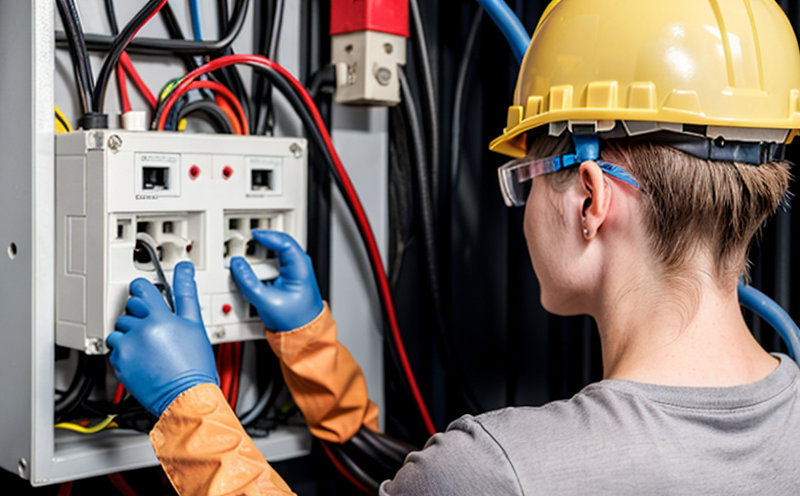IEC 60598 Luminaires Electrical Safety Testing for Smart Lighting
The International Electrotechnical Commission (IEC) standard IEC 60598 is a critical framework for ensuring the safety and reliability of luminaires, particularly in the context of smart lighting systems. This standard encompasses a wide range of tests designed to evaluate the electrical safety aspects of luminaires used in residential, commercial, and industrial settings.
The focus on electrical safety is paramount given the increasing integration of smart technology into lighting systems. Smart lighting devices are not only responsible for illuminating spaces but also for providing energy efficiency, convenience, and automation capabilities. However, this technological advancement introduces new risks that must be mitigated through stringent testing procedures.
IEC 60598 covers various types of luminaires, including those with electronic ballasts, dimming capabilities, and wireless communication interfaces. The standard ensures that these devices meet the highest safety standards by addressing potential hazards such as electrical shock, fire risk, and electromagnetic interference (EMI). Compliance with IEC 60598 is essential for manufacturers to ensure their products are safe for use in smart home ecosystems.
The testing procedures outlined in IEC 60598 include a series of tests that assess the electrical safety aspects of luminaires. These tests encompass insulation resistance, creepage and clearance distances, withstand voltage, dielectric strength, and protection against electric shock. The standard also includes specific requirements for smart lighting devices, which involve additional considerations such as communication protocols and interoperability with other smart home systems.
Manufacturers must adhere to these stringent testing procedures before bringing their products to market. By doing so, they not only comply with international standards but also enhance the overall safety of their products. This is especially important in the context of smart lighting, where a single device failure could potentially compromise the entire network of connected devices.
The importance of electrical safety cannot be overstated, particularly given the increasing reliance on smart home technology. A single incident involving a non-compliant luminaire can lead to severe consequences, including personal injury and property damage. Therefore, it is imperative for manufacturers to invest in thorough testing and certification processes to ensure their products meet the highest safety standards.
Why It Matters
The importance of electrical safety in smart lighting cannot be understated. As more devices become interconnected through wireless communication protocols, the potential risks associated with electrical faults increase significantly. Ensuring compliance with IEC 60598 standards is crucial for maintaining a safe and secure environment.
- Reduces the risk of electrical shock
- Mitigates fire hazards
- Promotes energy efficiency through reliable performance
- Ensures interoperability within smart home ecosystems
The standard's emphasis on robust design and manufacturing practices helps to prevent failures that could lead to catastrophic events. By adhering to the requirements set forth in IEC 60598, manufacturers can enhance consumer confidence and trust in their products.
Moreover, compliance with these standards is not only a legal requirement but also a competitive advantage. In today's market, where sustainability and safety are key considerations for consumers, adherence to international standards demonstrates a commitment to quality and excellence. This can differentiate a brand from its competitors and foster long-term relationships with customers.
Benefits
The benefits of conducting IEC 60598 luminaires electrical safety testing are manifold:
- Promotes Consumer Safety: Ensures that products meet the highest safety standards, reducing the risk of accidents and injuries.
- Increases Market Access: Compliance with international standards can open doors to new markets and opportunities for growth.
- Safeguards Brand Reputation: Demonstrating a commitment to quality and safety enhances brand reputation and customer trust.
- Promotes Energy Efficiency: Reliable performance contributes to overall energy efficiency, reducing environmental impact.
By investing in thorough testing and certification processes, manufacturers can ensure that their products meet the highest safety standards. This not only protects consumers but also enhances brand reputation and market access.
Use Cases and Application Examples
| Application Example | Description |
|---|---|
| Smart Home Lighting System Integration | Incorporation of smart lighting devices into home automation systems, ensuring seamless communication and operation. |
| Commercial Building Lighting Optimization | Deployment in large commercial spaces to enhance energy efficiency and reduce operational costs. |
| Smart City Infrastructure | Integration of smart lighting into urban infrastructure for enhanced public safety and environmental sustainability. |
| Retail Store Lighting Solutions | Enhancing customer experience through adaptive lighting systems that adjust based on occupancy and time of day. |
The use cases for smart lighting are diverse, ranging from residential applications to large-scale commercial deployments. In each case, ensuring compliance with IEC 60598 standards is critical to maintaining safety and reliability in the face of technological innovation.





